headlights Lancia Musa 2010 Owner handbook (in English)
[x] Cancel search | Manufacturer: LANCIA, Model Year: 2010, Model line: Musa, Model: Lancia Musa 2010Pages: 218, PDF Size: 3.71 MB
Page 119 of 218
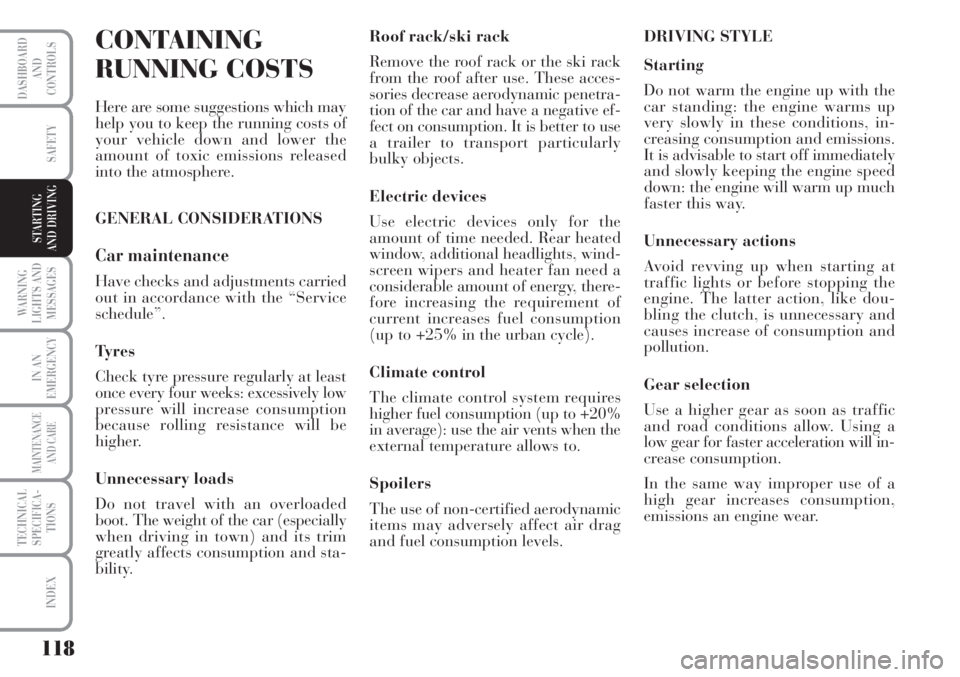
118
WARNING
LIGHTS AND
MESSAGES
IN AN
EMERGENCY
MAINTENANCE
AND CARE
TECHNICAL
SPECIFICA-
TIONS
INDEX
DASHBOARD
AND
CONTROLS
SAFETY
STARTING
AND DRIVING
CONTAINING
RUNNING COSTS
Here are some suggestions which may
help you to keep the running costs of
your vehicle down and lower the
amount of toxic emissions released
into the atmosphere.
GENERAL CONSIDERATIONS
Car maintenance
Have checks and adjustments carried
out in accordance with the “Service
schedule”.
Ty r e s
Check tyre pressure regularly at least
once every four weeks: excessively low
pressure will increase consumption
because rolling resistance will be
higher.
Unnecessary loads
Do not travel with an overloaded
boot. The weight of the car (especially
when driving in town) and its trim
greatly affects consumption and sta-
bility.Roof rack/ski rack
Remove the roof rack or the ski rack
from the roof after use. These acces-
sories decrease aerodynamic penetra-
tion of the car and have a negative ef-
fect on consumption. It is better to use
a trailer to transport particularly
bulky objects.
Electric devices
Use electric devices only for the
amount of time needed. Rear heated
window, additional headlights, wind-
screen wipers and heater fan need a
considerable amount of energy, there-
fore increasing the requirement of
current increases fuel consumption
(up to +25% in the urban cycle).
Climate control
The climate control system requires
higher fuel consumption (up to +20%
in average): use the air vents when the
external temperature allows to.
Spoilers
The use of non-certified aerodynamic
items may adversely affect air drag
and fuel consumption levels.DRIVING STYLE
Starting
Do not warm the engine up with the
car standing: the engine warms up
very slowly in these conditions, in-
creasing consumption and emissions.
It is advisable to start off immediately
and slowly keeping the engine speed
down: the engine will warm up much
faster this way.
Unnecessary actions
Avoid revving up when starting at
traffic lights or before stopping the
engine. The latter action, like dou-
bling the clutch, is unnecessary and
causes increase of consumption and
pollution.
Gear selection
Use a higher gear as soon as traffic
and road conditions allow. Using a
low gear for faster acceleration will in-
crease consumption.
In the same way improper use of a
high gear increases consumption,
emissions an engine wear.
Page 126 of 218

125
IN AN
EMERGENCY
MAINTENANCE
AND CARE
TECHNICAL
SPECIFICA-
TIONS
INDEX
DASHBOARD
AND
CONTROLS
SAFETY
STARTING
AND DRIVING
WARNING
LIGHTS AND
MESSAGES
WARNING LIGHTS AND MESSAGES
GENERAL WARNINGS..................................... 126
LOW BRAKE FLUID LEVEL ........................... 126
HANDBRAKE APPLIED.................................... 126
AIRBAG FAILURE............................................ 126
HOT ENGINE COOLANT............................... 127
LOW BATTERY CHARGE ............................... 127
LOW ENGINE OIL PRESSURE.............................128
EXHAUSTED OIL ........................................... 128
“DUALDRIVE” ELECTRIC POWER
STEERING SYSTEM ........................................ 129
DOOR OPEN .................................................... 129
SEAT BELT REMINDER....................................... 129
EBD FAILURE ................................................. 129
INJECTION SYSTEM FAILURE....................... 129
EOBD ENGINE CONTROL SYSTEM
FAILURE.......................................................... 129
FRONT PASSENGER AIRBAG DEACTIVATED.. 130
ABS FAILURE .................................................. 131
FUEL RESERVE .............................................. 131
GLOW PLUGS ................................................. 131GLOW PLUG FAILURE................................... 131
WATER IN DIESEL FUEL FILTER ................ 131
LANCIA CODE PROTECTION SYSTEM
FAILURE ......................................................... 132
REAR FOG LIGHTS ......................................... 132
GENERIC INDICATION ................................... 132
WORN BRAKE PADS ...................................... 133
OBSTRUCTED PARTICULATE TRAP ............. 133
SIDE, TAILLIGHTS AND DIPPED BEAM
HEADLIGHTS .................................................. 133
FOLLOW ME HOME ....................................... 133
FOG LIGHTS .................................................. 133
LEFT-HAND DIRECTION INDICATOR .......... 134
RIGHT-HAND DIRECTION INDICATOR ........ 134
“DUALDRIVE” ELECTRIC POWER
STEERING SYSTEM ON .................................. 134
CRUISE CONTROL ........................................ 134
MAIN BEAM HEADLIGHTS ............................. 134
POSSIBLE ICE ON ROAD ................................ 134
LIMITED RANGE ............................................. 134
Page 135 of 218
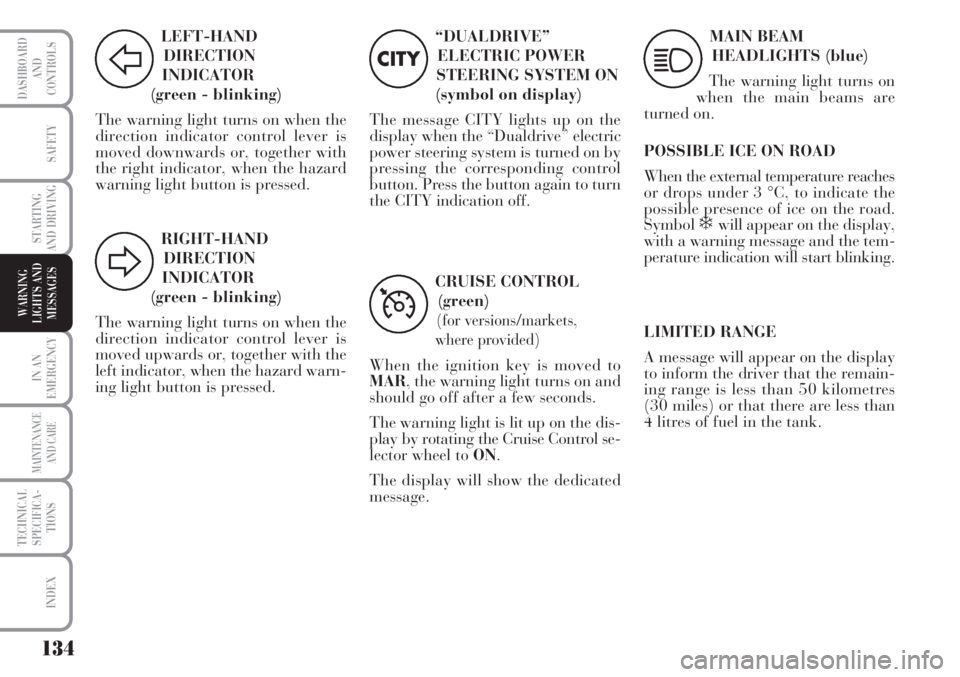
134
IN AN
EMERGENCY
MAINTENANCE
AND CARE
TECHNICAL
SPECIFICA-
TIONS
INDEX
DASHBOARD
AND
CONTROLS
SAFETY
STARTING
AND DRIVING
WARNING
LIGHTS AND
MESSAGES
LEFT-HAND
DIRECTION
INDICATOR
(green - blinking)
The warning light turns on when the
direction indicator control lever is
moved downwards or, together with
the right indicator, when the hazard
warning light button is pressed.
F
RIGHT-HAND
DIRECTION
INDICATOR
(green - blinking)
The warning light turns on when the
direction indicator control lever is
moved upwards or, together with the
left indicator, when the hazard warn-
ing light button is pressed.
D
“DUALDRIVE”
ELECTRIC POWER
STEERING SYSTEM ON
(symbol on display)
The message CITY lights up on the
display when the “Dualdrive” electric
power steering system is turned on by
pressing the corresponding control
button. Press the button again to turn
the CITY indication off.
CITY
CRUISE CONTROL
(green)
(for versions/markets,
where provided)
When the ignition key is moved to
MAR, the warning light turns on and
should go off after a few seconds.
The warning light is lit up on the dis-
play by rotating the Cruise Control se-
lector wheel to ON.
The display will show the dedicated
message.
Ü
MAIN BEAM
HEADLIGHTS (blue)
The warning light turns on
when the main beams are
turned on.
POSSIBLE ICE ON ROAD
When the external temperature reaches
or drops under 3 °C, to indicate the
possible presence of ice on the road.
Symbol
❄ will appear on the display,
with a warning message and the tem-
perature indication will start blinking.
1
LIMITED RANGE
A message will appear on the display
to inform the driver that the remain-
ing range is less than 50 kilometres
(30 miles) or that there are less than
4 litres of fuel in the tank.
Page 150 of 218
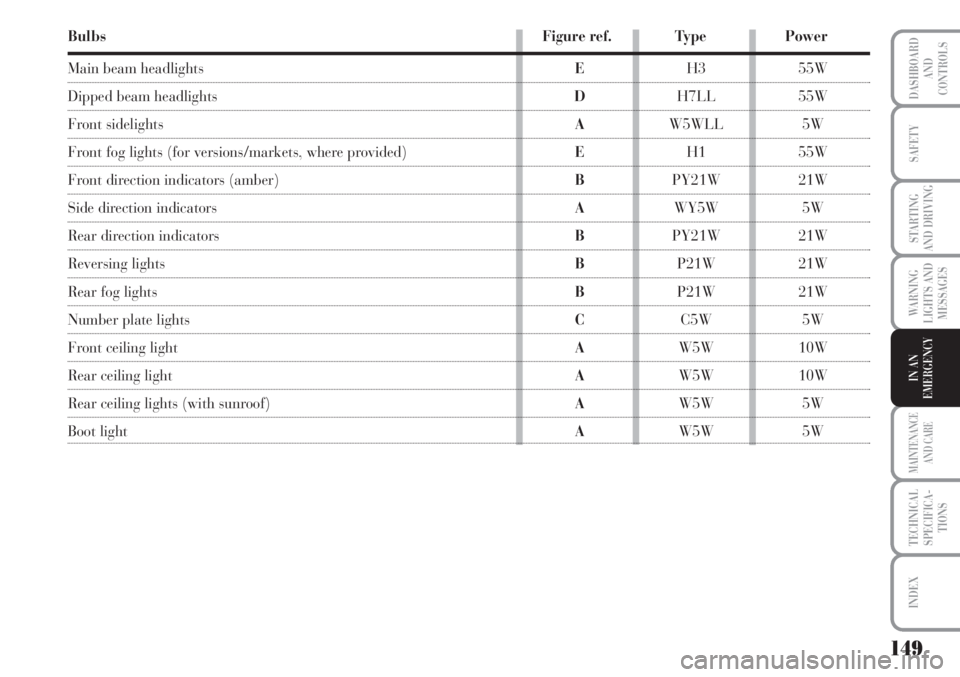
149
WARNING
LIGHTS AND
MESSAGES
MAINTENANCE
AND CARE
TECHNICAL
SPECIFICA-
TIONS
INDEX
DASHBOARD
AND
CONTROLS
SAFETY
STARTING
AND DRIVING
IN AN
EMERGENCY
Bulbs Figure ref. Type Power
Main beam headlightsEH3 55W
Dipped beam headlights DH7LL 55W
Front sidelights AW5WLL 5W
Front fog lights (for versions/markets, where provided)EH1 55W
Front direction indicators (amber)BPY21W 21W
Side direction indicators AWY5W 5W
Rear direction indicators BPY21W 21W
Reversing lights BP21W 21W
Rear fog lights BP21W 21W
Number plate lights CC5W 5W
Front ceiling light AW5W 10W
Rear ceiling lightAW5W 10W
Rear ceiling lights (with sunroof)AW5W 5W
Boot light AW5W 5W
Page 151 of 218
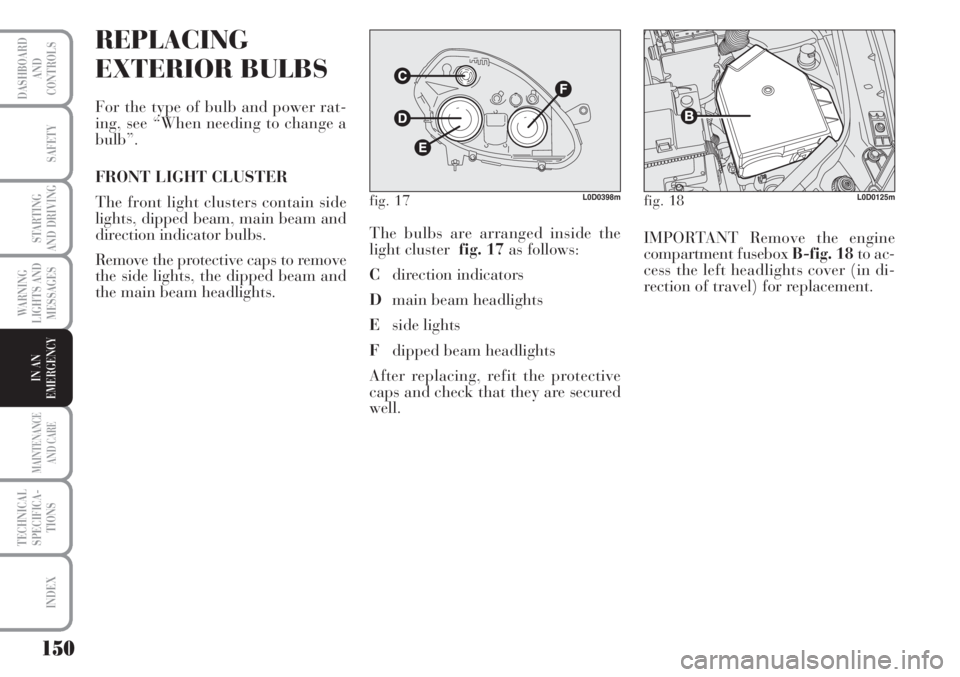
150
WARNING
LIGHTS AND
MESSAGES
MAINTENANCE
AND CARE
TECHNICAL
SPECIFICA-
TIONS
INDEX
DASHBOARD
AND
CONTROLS
SAFETY
STARTING
AND DRIVING
IN AN
EMERGENCY
REPLACING
EXTERIOR BULBS
For the type of bulb and power rat-
ing, see “When needing to change a
bulb”.
FRONT LIGHT CLUSTER
The front light clusters contain side
lights, dipped beam, main beam and
direction indicator bulbs.
Remove the protective caps to remove
the side lights, the dipped beam and
the main beam headlights.The bulbs are arranged inside the
light cluster fig. 17as follows:
Cdirection indicators
Dmain beam headlights
Eside lights
Fdipped beam headlights
After replacing, refit the protective
caps and check that they are secured
well.IMPORTANT Remove the engine
compartment fusebox B-fig. 18to ac-
cess the left headlights cover (in di-
rection of travel) for replacement.
fig. 17L0D0398mfig. 18L0D0125m
Page 152 of 218
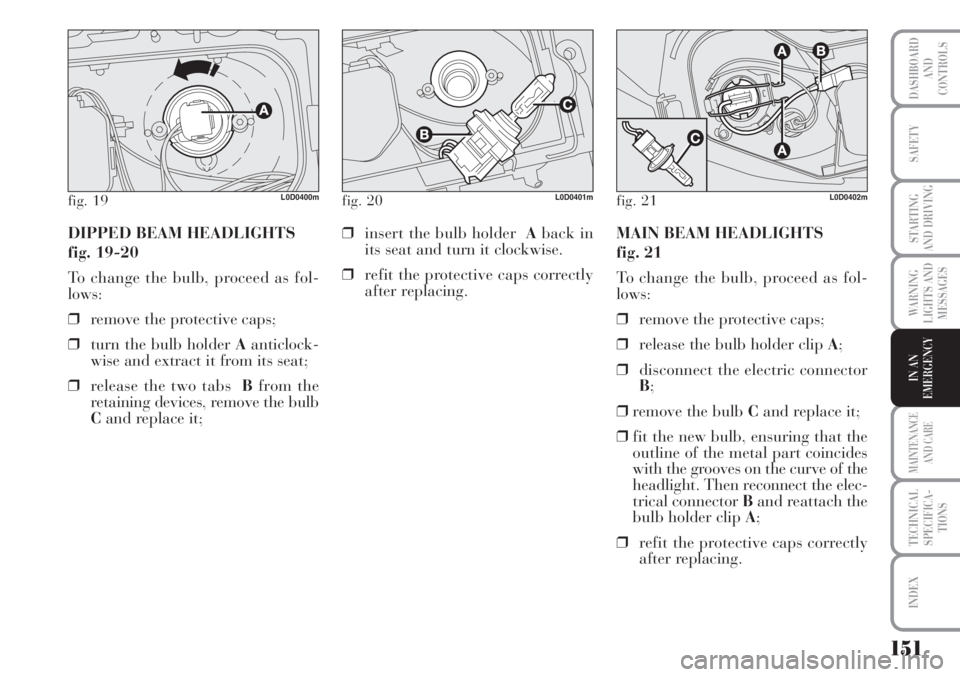
151
WARNING
LIGHTS AND
MESSAGES
MAINTENANCE
AND CARE
TECHNICAL
SPECIFICA-
TIONS
INDEX
DASHBOARD
AND
CONTROLS
SAFETY
STARTING
AND DRIVING
IN AN
EMERGENCY
DIPPED BEAM HEADLIGHTS
fig. 19-20
To change the bulb, proceed as fol-
lows:
❒remove the protective caps;
❒turn the bulb holder Aanticlock-
wise and extract it from its seat;
❒release the two tabs Bfrom the
retaining devices, remove the bulb
Cand replace it;❒insert the bulb holder Aback in
its seat and turn it clockwise.
❒refit the protective caps correctly
after replacing.MAIN BEAM HEADLIGHTS
fig. 21
To change the bulb, proceed as fol-
lows:
❒remove the protective caps;
❒release the bulb holder clip A;
❒disconnect the electric connector
B;
❒remove the bulb Cand replace it;
❒fit the new bulb, ensuring that the
outline of the metal part coincides
with the grooves on the curve of the
headlight. Then reconnect the elec-
trical connector Band reattach the
bulb holder clip A;
❒refit the protective caps correctly
after replacing.
fig. 20L0D0401mfig. 21L0D0402mfig. 19L0D0400m
Page 168 of 218
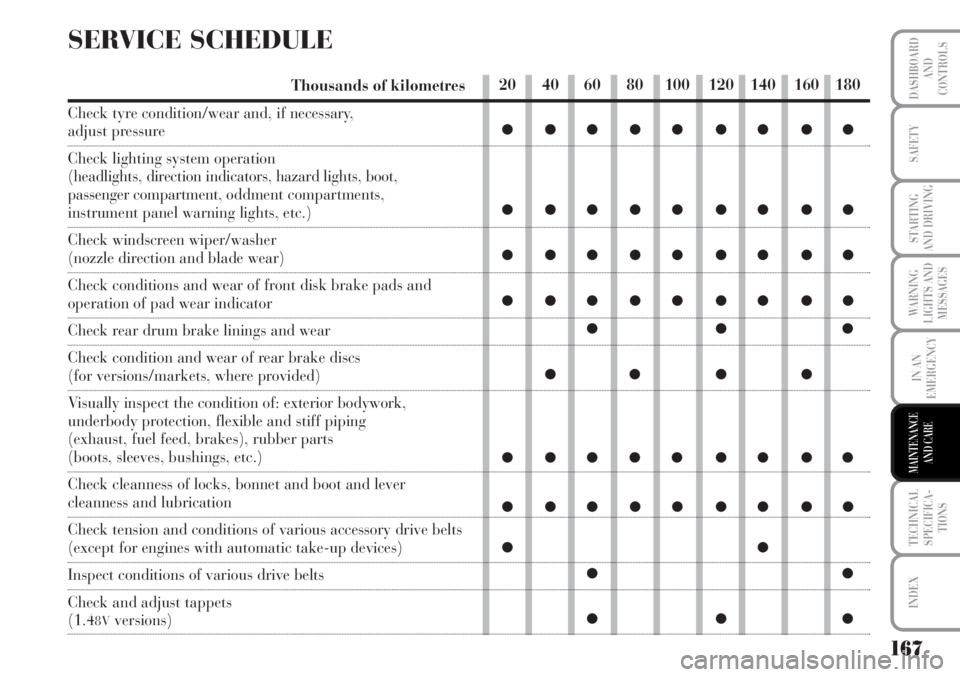
167
WARNING
LIGHTS AND
MESSAGES
TECHNICAL
SPECIFICA-
TIONS
INDEX
DASHBOARD
AND
CONTROLS
SAFETY
STARTING
AND DRIVING
IN AN
EMERGENCY
MAINTENANCE
AND CARE
SERVICE SCHEDULE
Thousands of kilometres
Check tyre condition/wear and, if necessary,
adjust pressure
Check lighting system operation
(headlights, direction indicators, hazard lights, boot,
passenger compartment, oddment compartments,
instrument panel warning lights, etc.)
Check windscreen wiper/washer
(nozzle direction and blade wear)
Check conditions and wear of front disk brake pads and
operation of pad wear indicator
Check rear drum brake linings and wear
Check condition and wear of rear brake discs
(for versions/markets, where provided)
Visually inspect the condition of: exterior bodywork,
underbody protection, flexible and stiff piping
(exhaust, fuel feed, brakes), rubber parts
(boots, sleeves, bushings, etc.)
Check cleanness of locks, bonnet and boot and lever
cleanness and lubrication
Check tension and conditions of various accessory drive belts
(except for engines with automatic take-up devices)
Inspect conditions of various drive belts
Check and adjust tappets
(1.48Vversions)
20 40 60 80 100 120 140 160 180
●●●●● ●●●●
●●●●● ●●●●
●●●●● ●●●●
●●●●● ●●●●
●●●
●● ● ●
●●●●● ●●●●
●●●●● ●●●●
●●
●●
●●●
Page 170 of 218
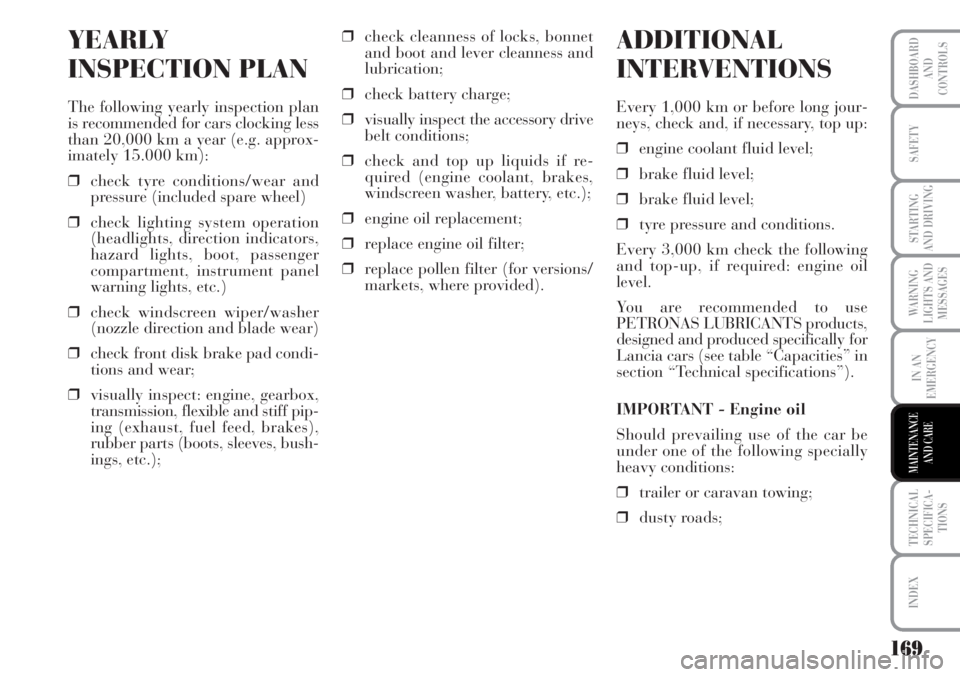
169
WARNING
LIGHTS AND
MESSAGES
TECHNICAL
SPECIFICA-
TIONS
INDEX
DASHBOARD
AND
CONTROLS
SAFETY
STARTING
AND DRIVING
IN AN
EMERGENCY
MAINTENANCE
AND CARE
YEARLY
INSPECTION PLAN
The following yearly inspection plan
is recommended for cars clocking less
than 20,000 km a year (e.g. approx-
imately 15.000 km):
❒check tyre conditions/wear and
pressure (included spare wheel)
❒check lighting system operation
(headlights, direction indicators,
hazard lights, boot, passenger
compartment, instrument panel
warning lights, etc.)
❒check windscreen wiper/washer
(nozzle direction and blade wear)
❒check front disk brake pad condi-
tions and wear;
❒visually inspect: engine, gearbox,
transmission, flexible and stiff pip-
ing (exhaust, fuel feed, brakes),
rubber parts (boots, sleeves, bush-
ings, etc.);❒check cleanness of locks, bonnet
and boot and lever cleanness and
lubrication;
❒check battery charge;
❒visually inspect the accessory drive
belt conditions;
❒check and top up liquids if re-
quired (engine coolant, brakes,
windscreen washer, battery, etc.);
❒engine oil replacement;
❒replace engine oil filter;
❒replace pollen filter (for versions/
markets, where provided).
ADDITIONAL
INTERVENTIONS
Every 1,000 km or before long jour-
neys, check and, if necessary, top up:
❒engine coolant fluid level;
❒brake fluid level;
❒brake fluid level;
❒tyre pressure and conditions.
Every 3,000 km check the following
and top-up, if required: engine oil
level.
You are recommended to use
PETRONAS LUBRICANTS products,
designed and produced specifically for
Lancia cars (see table “Capacities” in
section “Technical specifications”).
IMPORTANT - Engine oil
Should prevailing use of the car be
under one of the following specially
heavy conditions:
❒trailer or caravan towing;
❒dusty roads;
Page 185 of 218
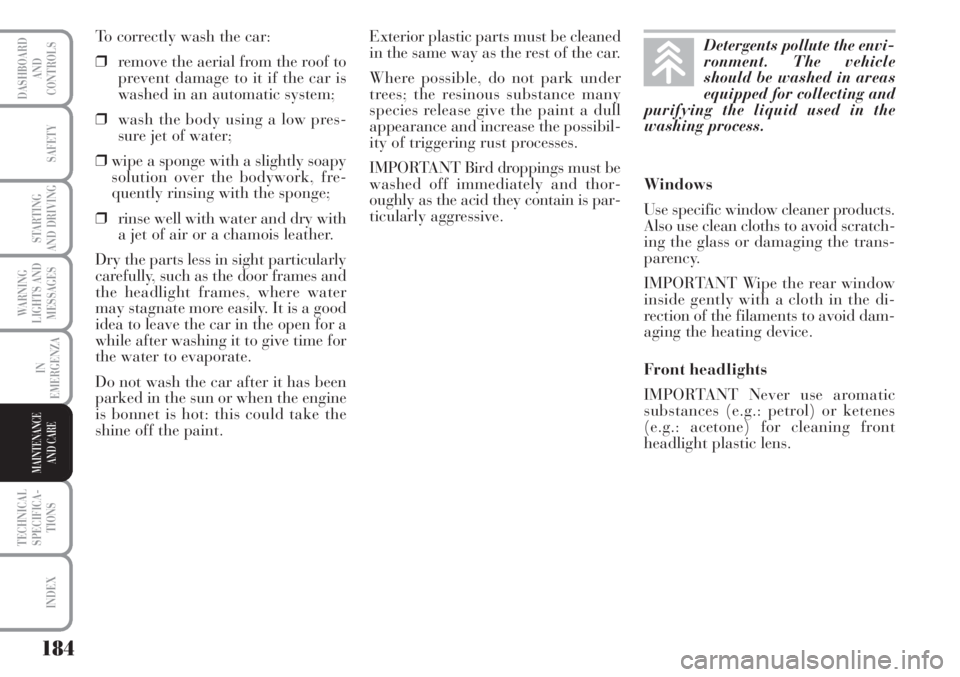
184
WARNING
LIGHTS AND
MESSAGES
TECHNICAL
SPECIFICA-
TIONS
INDEX
DASHBOARD
AND
CONTROLS
SAFETY
STARTING
AND DRIVING
IN
EMERGENZA
MAINTENANCE
AND CARE
To correctly wash the car:
❒remove the aerial from the roof to
prevent damage to it if the car is
washed in an automatic system;
❒wash the body using a low pres-
sure jet of water;
❒wipe a sponge with a slightly soapy
solution over the bodywork, fre-
quently rinsing with the sponge;
❒rinse well with water and dry with
a jet of air or a chamois leather.
Dry the parts less in sight particularly
carefully, such as the door frames and
the headlight frames, where water
may stagnate more easily. It is a good
idea to leave the car in the open for a
while after washing it to give time for
the water to evaporate.
Do not wash the car after it has been
parked in the sun or when the engine
is bonnet is hot: this could take the
shine off the paint.Exterior plastic parts must be cleaned
in the same way as the rest of the car.
Where possible, do not park under
trees; the resinous substance many
species release give the paint a dull
appearance and increase the possibil-
ity of triggering rust processes.
IMPORTANT Bird droppings must be
washed off immediately and thor-
oughly as the acid they contain is par-
ticularly aggressive.Windows
Use specific window cleaner products.
Also use clean cloths to avoid scratch-
ing the glass or damaging the trans-
parency.
IMPORTANT Wipe the rear window
inside gently with a cloth in the di-
rection of the filaments to avoid dam-
aging the heating device.
Front headlights
IMPORTANT Never use aromatic
substances (e.g.: petrol) or ketenes
(e.g.: acetone) for cleaning front
headlight plastic lens.Detergents pollute the envi-
ronment. The vehicle
should be washed in areas
equipped for collecting and
purifying the liquid used in the
washing process.
Page 207 of 218
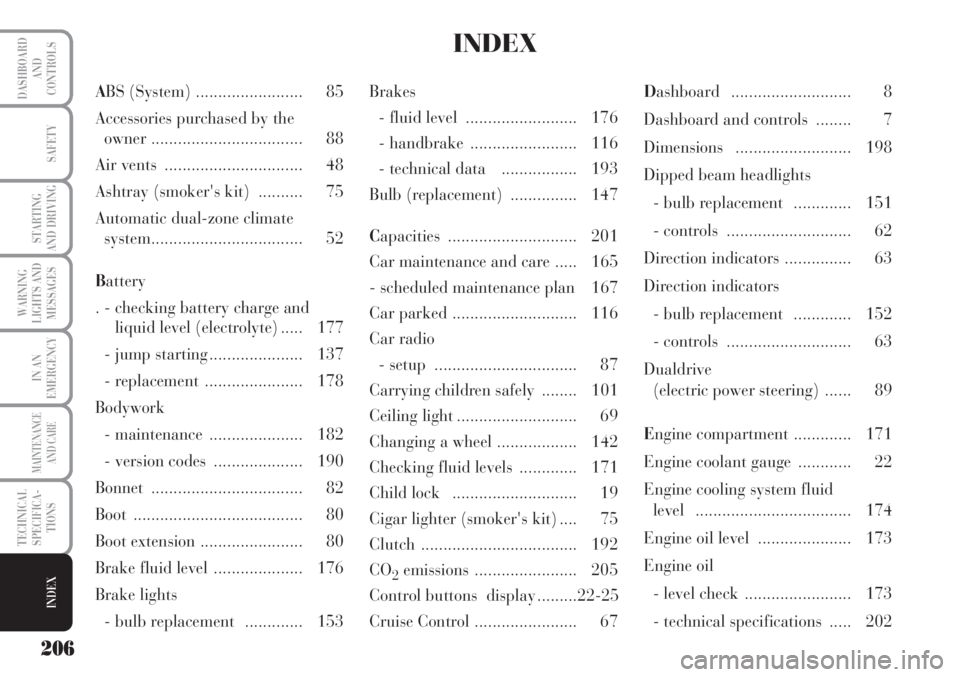
206
WARNING
LIGHTS AND
MESSAGES
DASHBOARD
AND
CONTROLS
SAFETY
STARTING
AND DRIVING
IN AN
EMERGENCY
MAINTENANCE
AND CARE
TECHNICAL
SPECIFICA-
TIONS
INDEX
ABS (System) ........................ 85
Accessories purchased by the
owner .................................. 88
Air vents ............................... 48
Ashtray (smoker's kit) .......... 75
Automatic dual-zone climate
system.................................. 52
Battery
. - checking battery charge and
liquid level (electrolyte) ..... 177
- jump starting ..................... 137
- replacement ...................... 178
Bodywork
- maintenance ..................... 182
- version codes .................... 190
Bonnet .................................. 82
Boot ...................................... 80
Boot extension ....................... 80
Brake fluid level .................... 176
Brake lights
- bulb replacement ............. 153Brakes
- fluid level ......................... 176
- handbrake ........................ 116
- technical data ................. 193
Bulb (replacement) ............... 147
Capacities ............................. 201
Car maintenance and care ..... 165
- scheduled maintenance plan 167
Car parked ............................ 116
Car radio
- setup ................................ 87
Carrying children safely ........ 101
Ceiling light ........................... 69
Changing a wheel .................. 142
Checking fluid levels ............. 171
Child lock ............................ 19
Cigar lighter (smoker's kit) .... 75
Clutch ................................... 192
CO
2emissions ....................... 205
Control buttons display .........22-25
Cruise Control ....................... 67Dashboard ........................... 8
Dashboard and controls ........ 7
Dimensions .......................... 198
Dipped beam headlights
- bulb replacement ............. 151
- controls ............................ 62
Direction indicators ............... 63
Direction indicators
- bulb replacement ............. 152
- controls ............................ 63
Dualdrive
(electric power steering) ...... 89
Engine compartment ............. 171
Engine coolant gauge ............ 22
Engine cooling system fluid
level ................................... 174
Engine oil level ..................... 173
Engine oil
- level check ........................ 173
- technical specifications ..... 202
INDEX